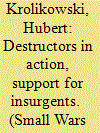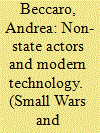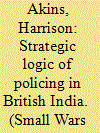|
|
|
Sort Order |
|
|
|
Items / Page
|
|
|
|
|
|
|
| Srl | Item |
| 1 |
ID:
191054


|
|
|
|
|
| Summary/Abstract |
After regaining independence in 1918, Poland faced many fundamental and strategic challenges. One of them was the issue of border crossings on the German-Polish border in Silesia. It was a region dominated by modern heavy industry, to which both the modern states laid claim. The course of the border was to be decided by a plebiscite, but the parties to the conflict resorted to violence and military means. In a complicated international situation and without the possibility of open military intervention, Poland effectively used the strategic tool of special operations – known more widely today as unconventional warfare. Thanks to their skillful application, the German military advantage was effectively eliminated and strategic goals were achieved. Poles effectively cut lines of communication, making it impossible to support pro-German organizations in Silesia, and successfully organized insurgent forces that achieved the goals important for Poland’s development policy. This paper tells the story of a special mission unit called the Destruction Group ‘Wawelberg’ and its use as a tool for implementing the state policy of unconventional warfare during the Third Silesian Uprising.
|
|
|
|
|
|
|
|
|
|
|
|
|
|
|
|
| 2 |
ID:
191046


|
|
|
|
|
| Summary/Abstract |
The conventional view has been that Trump and Biden made the correct decision to withdraw the US from Afghanistan, but the actual departure was flawed. On the contrary, the US should not have withdrawn and the actual departure was not a failure. The withdrawal was against the US’ larger strategic interests beyond counterterrorism. If it withdrew, it should not have done so unconditionally, for both its interests (including humanitarian) and assets were substantial. The US should not have negotiated with the Taliban absent the Afghan government, thereby undermining the government’s and its security forces’ will to fight. Thus, the success of the Taliban’s revolution owed more to the Afghan government’s collapse than its revolutionary mobilization. In withdrawing from Afghanistan, the US showed that it failed to learn lessons from its withdrawal from Iraq in 2011, which led to internal political decay in Iraq, the re-emergence of terrorism, and larger strategic setbacks for Washington. More broadly, the US failed to appreciate how its withdrawal of support for regimes dependent on it often facilitates the coming to power of hostile revolutionary movements.
|
|
|
|
|
|
|
|
|
|
|
|
|
|
|
|
| 3 |
ID:
191049


|
|
|
|
|
| Summary/Abstract |
The paper focuses on how technology impacts on irregular conflicts, i.e. conflicts fought by non-state actors. The ability to inflict destruction and produce casualties is no longer directly related to the ability to organize large numbers of people and manage vast stores of resources that has been typical of large, organized state armies, and consequently smaller groups can now inflict more serious and extensive damage than their predecessors. It follows that the relationship between irregular fighters and technology is one of the most crucial elements in understanding contemporary conflicts. The paper is divided into five sections. The first is a brief paragraph focused on the definition problem, explaining why and how we use the term ‘irregular fighters’, and the second is a historical overview on how the relationship between ‘irregular fighters’ and technology has changed in the last two centuries. The third section is a study of current trends in the relationship between modern technology and current irregular warfare. The fourth section is intended to study current impacts of technology on irregular warfare, looking at ISIS’s operations in 2016–2017 and its use of drones. Finally, the conclusions section presents both lessons learned and findings.
|
|
|
|
|
|
|
|
|
|
|
|
|
|
|
|
| 4 |
ID:
191047


|
|
|
|
|
| Summary/Abstract |
The reported militarization of the Horn of Africa by Middle Eastern states has generated great interest among scholars and analysts alike. Their analyses and articles about the projections of power from the Middle East to the Horn of Africa are exaggerated, however, because they underappreciate the extant and enduring security burdens of the states in question and overestimate their national power capabilities. This is largely due to common misperceptions and faulty measures of military power. The question that this article answers is therefore not whether states such as Turkey or the United Arab Emirates (UAE) could redeploy limited military resources extra-regionally, but why would they and for how long? Using empirical data from interviews, defence statistics and data from recent deployments of the UAE and Turkey, we show how these key players are inhibited from prospective, long-term, and sustained deployments extra-territorially. This is supported by our analysis of the two states’ power capabilities (latent and actual) and their security burdens that constrain and limit options for the use of military tools abroad in the pursuit of foreign policy aims. This has led both Turkey and the UAE to engage in various forms of remote warfare involving local partners, allied militias, and mercenaries.
|
|
|
|
|
|
|
|
|
|
|
|
|
|
|
|
| 5 |
ID:
191051


|
|
|
|
|
| Summary/Abstract |
For Western militaries, the choice between enemy-centric and population-centric approaches to unconventional warfare is really no choice at all. Contemporary counterinsurgency doctrines are clear on the decisive importance of hearts and minds in delivering success: in these conflicts, the population is the prize. As this article identifies, however, context may limit in important ways the relevance of many hearts and minds activities. Despite the scale of Commonwealth military success against Indonesia during Operation Claret in 1965–66, and despite the declared importance of hearts and mind activities in support of this success, the specific context that existed during the campaign limited the extent to which hearts and minds could exert a decisive impact. In particular, the limited nature of Commonwealth objectives, which did not seek to change the political ownership of the border area, meant that the local population could not, in the long term, be protected from the consequences of choosing to side with Commonwealth forces. Therefore, despite often being well disposed to Commonwealth troops, rational concerns for their own well-being limited the willingness of border villagers to provide overt help.
|
|
|
|
|
|
|
|
|
|
|
|
|
|
|
|
| 6 |
ID:
191053


|
|
|
|
|
| Summary/Abstract |
Within British India, the police were used to suppress challenges to colonial authority. Yet, police actions in fulfilling this role varied by region. Within the provinces, the police were a coercive force to enforce internal security, augmenting military efforts. On the frontier, the aim of the police was to integrate locals into the local security framework and weld their interests to government control, rather than the direct application of force. Relying on Indian archival records, this comparative analysis demonstrates the importance of considering this variation for a more complete understanding of the strategic logic of colonial policing.
|
|
|
|
|
|
|
|
|
|
|
|
|
|
|
|
|
|
|
|
|